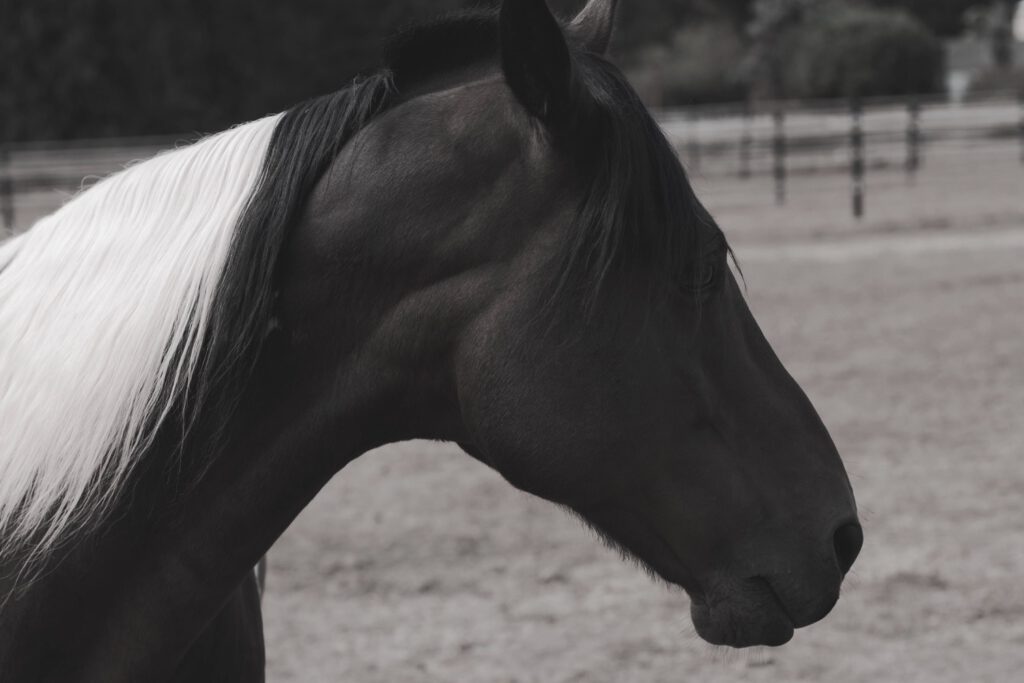Whether for professionals, riders, or enthusiasts, understanding the horse’s oral cavity and dentition is essential. In this article, we will give you all the elements related to the teeth of the horse and the evolution of the teeth according to its age.

The oral cavity of the horse
It is centered on a narrow and long lingual canal, communicates on each side with a vestibule, limited itself laterally by the cheeks, the lips. Its ceiling, formed by the hard and soft palates, ends with the isthmus of the gullet. The lips, muscular at their attachment, thinned at their free edge, are mobile and prehensile. The hard palate is followed by the extremely long soft palate (soft palate), placed in front of the epiglottis. Between the soft palate and the root of the tongue, the isthmus of the gullet is narrow. This arrangement prevents all mouth breathing and vomiting in the horse. The pharynx, crossroads of the digestive and respiratory tracts, communicates with the nasal cavities through the choanae, it overhangs the entrance of the larynx and is prolonged by the esophagus. On its lateral wall we find the opening of the auditory tube, a long mucous canal which communicates with the middle ear and forms a kind of hernia, filled with air: the guttural pouch. We do not know what the role of this organ is specific to equids, but it represents an essential element in equine pathology.
The dentition of the horse
The adult dentition includes 36 to 42 teeth with on each side of the median plane, 3 upper incisors and 3 lower incisors distinguished in pincer (central), middle and wedge (lateral) and, in a constant way in the male, a canine at the top and bottom (brehaigne mare when this tooth exists in the female). The premolars are 4 upper and 3 lower (difference due to the persistence in the adult of a small milk tooth) and the molars are 3 and 3.
The incisors of the horse
The morphology of the incisors is complex because they are teeth with prolonged growth. They grow by their embedded end as they are worn by their free end.
In young people, they have no real root and are all crowned. In the adult, they have lost part of their crown, but begin to possess a root. In older animals, the root is completely developed, while the crown is very reduced; they are therefore never complete.
On the other hand, these incisors do not have the same shape from their free end to their embedded end, which changes the proportions of the wear table.
Their embedded end has an internal dental cavity containing the dental pulp, which is progressively filled by apposition of secondary dentin. The free end of the tooth has another cavity, the external dental horn, lined with enamel and containing cementum. The progressive wear of the tooth eventually makes this horn disappear, while the secondary dentine appears, in the form of a dark mark: the dental star.
All these characteristics give chronological indications on the age of the animal.
The upper teeth, massive parallelepipedal shafts, have a square dental table, inclined obliquely towards the cheek, clearly overhanging the lower tooth. On this table we can distinguish protruding denticles of enamel, bordering the entrance of 2 dental cones, drawing a characteristic B. Their embedded end presents 4 roots (the 1st and the 6th present only 3).
The lower teeth of the horse
The lower teeth are narrower and have a rectangular table with an E-shaped enamel fold pattern. They have only 2 roots.
The milk teeth are reduced to 3 upper and 3 lower incisors, no (or very rudimentary) canines, 3 or 4 upper premolars (the first of which evolves late and persists in the adult) and 3 lower premolars. These are all teeth with rapid and limited growth.
Evolution of the horse’s dentition according to age
The shape of the incisor arches, the way the incisors meet each other and their orientation on the arch is first evaluated on an adult animal. At 5 years old, when the mouth is “made”, the confrontation is in “niçoise bite”, with divergent teeth on a “basket-handle” arch; around 10 years old, the confrontation is in ogive, the teeth are parallel on a lowered arch and, from 15 years old, the confrontation is angular, the teeth are convergent on a rectilinear arch
The canines are small, hook-shaped teeth that grow rapidly.
The morphology of premolars and molars in horses is particular since there is a molarization of the premolars. This means that these two types of teeth, different in other species, have the same morphology here. They are also teeth with prolonged growth and therefore never complete.
When the animal is less than 5 years old, we examine the dates of eruption of the deciduous teeth, their fall, and their replacement. From the age of 5, the changes in the shape of the incisors are assessed, the appearance of cementum in the dental horn (shaving stage), the appearance of the dental star, and then the disappearance of the dental horn (leveling stage). The criteria for diagnosing age become more imprecise
To learn more: understanding your horse’s teeth


